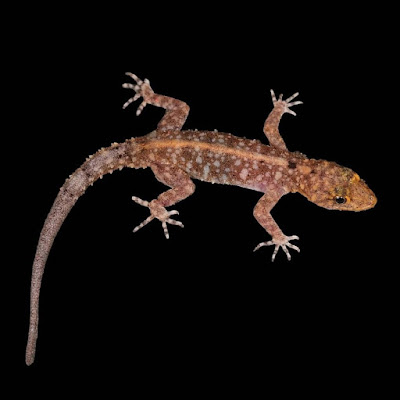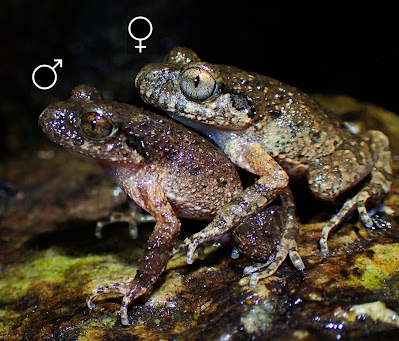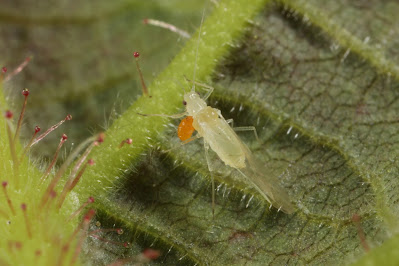[Most Recent Entries] [Calendar View]
Friday, April 2nd, 2021
| Time | Event | ||||||
| 5:31a | [Herpetology • 2020] Cnemaspis stellapulvis • A New Cryptic Cnemaspis Strauch (Squamata: Gekkonidae) from An isolated Granite Hill on the Mysore Plateau, Karnataka, India
Abstract We describe a cryptic new species of the Cnemaspis mysoriensis complex from an isolated rocky hillock near Yadiyur, Mandya District of south Karnataka, India. Cnemaspis stellapulvis sp. nov. can be diagnosed from all other peninsular Indian congeners by its small body size (SVL <32 mm), presence of spine-like tubercles on the flanks, heterogeneous dorsal pholidosis, two or three femoral pores on each thigh separated on either side by eight poreless scales from a continuous series of two precloacal pores in males, tail with enlarged, strongly keeled, conical tubercles forming whorls, median row of sub-caudals smooth and slightly enlarged, and a distinct colour pattern. The new species can be diagnosed from members of C. mysoriensis clade by the number of femoral and precloacal pores and number of poreless scales separating these series, the number of dorsal tubercles rows at mid-body, the number of ventral scales across the belly at mid-body and subtle colour pattern differences; besides 13.4–21.4 % uncorrected ND2 sequence divergence. In this paper, we define the Cnemaspis mysoriensis clade and provide a diagnosis and comparison against peninsular Indian congeners. We also provide major diagnostic characters for members of the C. mysoriensis clade. The discovery of yet another endemic species of Cnemaspis from one of the many isolated granite rocky hills on Mysore Plateau highlights the possibilities of presence of many more cryptic undescribed species. Keywords: Reptilia, dwarf geckos, endemic, granite boulders, microrefugia, ND2, South Asian Cnemaspis, systematics Cnemaspis stellapulvis sp. nov. Akshay Khandekar, Tejas Thackeray and Ishan Agarwal. 2020. A New Cryptic Cnemaspis Strauch (Squamata: Gekkonidae) from An isolated Granite Hill on the Mysore Plateau, Karnataka, India. Zootaxa. 4845(4); 509–528. DOI: 10.11646/zootaxa.4845.4.3 | ||||||
| 8:45a | [Herpetology • 2021] Novel Reproductive Behavior in An Asian Frog: Sex‐reversed Inguinal Amplexus [Leptobrachella laui; Megophryidae]
Abstract Amphibians exhibit diverse reproductive behaviors, including nine documented types of amplexus, the behavior in which male and female frogs position themselves for courtship, oviposition, and fertilization. All known forms of amplexus involve the male on top of or in line horizontally (cloacal apposition) with the female. Here, we report a novel form of amplexus observed in Lau’s leaf litter toad (Leptobrachella laui; Megophryidae) in Hong Kong, China. Termed “sex‐reversed inguinal amplexus,” the female climbs on top of a male and the male transports the female to a concealed breeding site. We were unable to determine whether this was the amplectant position in which frogs engaged during oviposition or solely during courtship and prior to oviposition, but there are a number of possible evolutionary drivers that may have given rise to this behavior, including limiting suitable oviposition sites or strong competition for males among females. Further research will be necessary to understand the evolutionary origins of this novel reproductive behavior. Keywords: amphibian, amplexus, behavioral ecology, Leptobrachella laui, Megophryidae, oviposition
Yik‐Hei Sung, Wing‐Ho Lee, Ho‐Nam Ng, Martha L. Crump and Nancy E. Karraker. 2021. Novel Reproductive Behavior in An Asian Frog: Sex‐reversed Inguinal Amplexus. Ecosphere - Naturalist. DOI: 10.1002/ecs2.3407 Lingnan University scholar discovers novel reproductive behaviour in native frog species | ||||||
| 9:07a | [Arachnida • 2021] Lassenia newelli • A Contribution to the Knowledge of the Enigmatic Tanaupodidae (Actinotrichida: Trombidiformes, Parasitengona) — Description of A New Species of Lassenia and A New Host Record
Abstract A new tanaupodid mite, Lassenia newelli sp. nov. is described based on a larva parasitising the aphid Myzocallis coryli (Goeze, 1778) (Aphididae) in Scotland, Great Britain. It is the ninth species of Lassenia known from the larval stage, the second host association for the genus and the first one for which the specific affiliation of both the parasite and its host is provided. The finding contributes to the taxonomy and biology of Tanaupodidae which have been considered to form one of the basal clades of Parasitengona. The discovery of elongate seta on the dorsal surface of tarsus III in L. newelli, a characteristic also shared by the monotypic Amphotrombium, supports the hypothesis of possible links between the tanaupodids and amphotrombiids as early derivative taxa of parasitengone mites. Keywords: Lassenia, larva, host, aphid, , Great Britain
Lassenia newelli sp. nov. Diagnosis: Larva. Anterior plate, encompassing the bases of ASens, well separated from the remaining part of scutum. fD = 20, fV = 6. fSt = 0-0. Anal sclerites with two setae, each. Two setae on palp femur. fCx = 2-2-1. Genu I with two solenidia. Lateral claws on tarsi simple. Etymology: The specific epithet is given to commemorate Irwin M. Newell (1916–1979), Professor of Zoology, for his contribution to the taxonomy and ecology of mites. Joanna Mąkol and Alan Watson Featherstone. 2021. A Contribution to the Knowledge of the Enigmatic Tanaupodidae (Actinotrichida: Trombidiformes, Parasitengona) — Description of A New Species of Lassenia and A New Host Record. Systematic & Applied Acarology. 26(4); 801–808. DOI: 10.11158/saa.26.4.10 |
| << Previous Day |
2021/04/02 [Calendar] |
Next Day >> |













